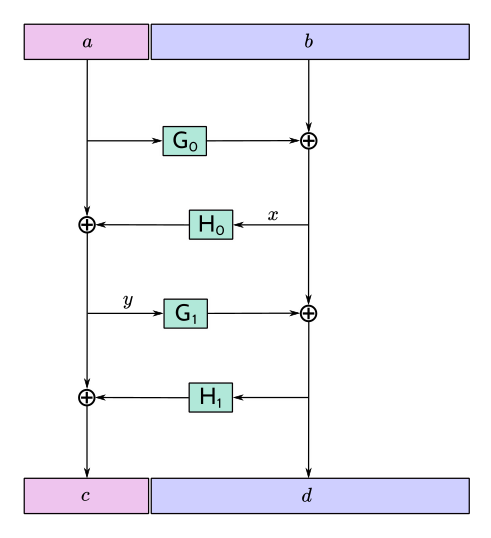Expand description
This crate provides a mechanism for “jumbling” byte slices in a reversible way.
Many byte encodings such as Base64 and Bech32 do not have “cascading” behaviour: changing an input byte at one position has no effect on the encoding of bytes at distant positions. This can be a problem if users generally check the correctness of encoded strings by eye, as they will tend to only check the first and/or last few characters of the encoded string. In some situations (for example, a hardware device displaying on its screen an encoded string provided by an untrusted computer), it is potentially feasible for an adversary to change some internal portion of the encoded string in a way that is beneficial to them, without the user noticing.
The function F4Jumble (and its inverse function, F4Jumble⁻¹) are length-preserving transformations can be used to trivially introduce cascading behaviour to existing encodings:
- Prepare the raw
messagebytes as usual. - Pass
messagethroughf4jumbleorf4jumble_mutto obtain the jumbled bytes. - Encode the jumbled bytes with the encoding scheme.
Changing any byte of message will result in a completely different sequence of
jumbled bytes. Specifically, F4Jumble uses an unkeyed 4-round Feistel construction to
approximate a random permutation.

Efficiency
The cost is dominated by 4 BLAKE2b compressions for message lengths up to 128 bytes. For longer messages, the cost increases to 6 BLAKE2b compressions for 128 < lₘ ≤ 192, and 10 BLAKE2b compressions for 192 < lₘ ≤ 256, for example. The maximum cost for which the algorithm is defined would be 196608 BLAKE2b compressions at lₘ = 4194368.
The implementations in this crate require memory of roughly lₘ bytes plus the size of
a BLAKE2b hash state. It is possible to reduce this by (for example, with F4Jumble⁻¹)
streaming the d part of the jumbled encoding three times from a less
memory-constrained device. It is essential that the streamed value of d is the same
on each pass, which can be verified using a Message Authentication Code (with key held
only by the Consumer) or collision-resistant hash function. After the first pass of
d, the implementation is able to compute y; after the second pass it is able to
compute a; and the third allows it to compute and incrementally parse b. The
maximum memory usage during this process would be 128 bytes plus two BLAKE2b hash
states.
Enums
Errors produced by F4Jumble.
Constants
Length of F4Jumbled message must lie in the range VALID_LENGTH.
Functions
stdEncodes the given message using F4Jumble, and returns the encoded message as a vector of bytes.
stdDecodes the given message using F4Jumble⁻¹, and returns the decoded message as a vector of bytes.
Decodes the given message in-place using F4Jumble⁻¹.
Encodes the given message in-place using F4Jumble.